Combined Impact of Climate Change and Land Qualities on Winter Wheat Yield in Central Fore-Caucasus: The Long-Term Retrospective Study
Abstract
:1. Introduction
2. Materials and Methods
2.1. Climate Impact
2.2. Land Use Impact
- Croplands: lands systematically cultivated for crop production, including perennial grasses and clean fallow;
- Rangelands: lands systematically and predominantly used for livestock grazing, including lands appropriate for livestock grazing but not used as hayfields or fallow;
- Hayfields: lands where herbaceous plants are systematically grown for hay;
- Perennial plantings: lands under homogeneous stands of arboreal plants, bushes, and herbaceous plants used for the production of horticultural, technical, and medical products;
- Residential and industrial lands: areas of intensive use in urban and suburban territories with much of the land covered by residential and industrial structures, including in the locations isolated from urban areas;
- Publicly protected lands: lands of state nature reserves, including biosphere reserves, state nature reserves, natural monuments, national parks, natural parks, dendrological parks, and botanical gardens;
- Other lands: lands under utilities, infrastructure, and waterworks facilities, as well as areas involved in processing, treatment, and transportation of water, gas, oil, and electricity.
2.3. The Multiplicative Climate–Yield Model
2.4. Territory
- Zone 1. East and Northeast: low precipitation (below 350 mm), high air temperature (+25 °C), the predominance of rangelands, very low humus content in soils (below 2.0%);
- Zone 2. Center and Northwest: medium precipitation (350–500 mm), moderate air temperature (+23–24 °C), the predominance of croplands, low humus content in soils (2.1–4.0%);
- Zone 3. West and Southwest: high precipitation (above 500 mm), moderate air temperature (+20–23 °C), croplands and rangelands, medium and high humus content in soils (above 4.1%).
2.5. Data
3. Results
3.1. Climate Impact
3.2. Land Use Impact
3.2.1. Stage I
3.2.2. Stage II
3.2.3. Stage III
3.2.4. Stage IV
3.3. Climate–Yield Models
4. Discussion
5. Conclusions
Author Contributions
Funding
Institutional Review Board Statement
Informed Consent Statement
Data Availability Statement
Conflicts of Interest
Appendix A
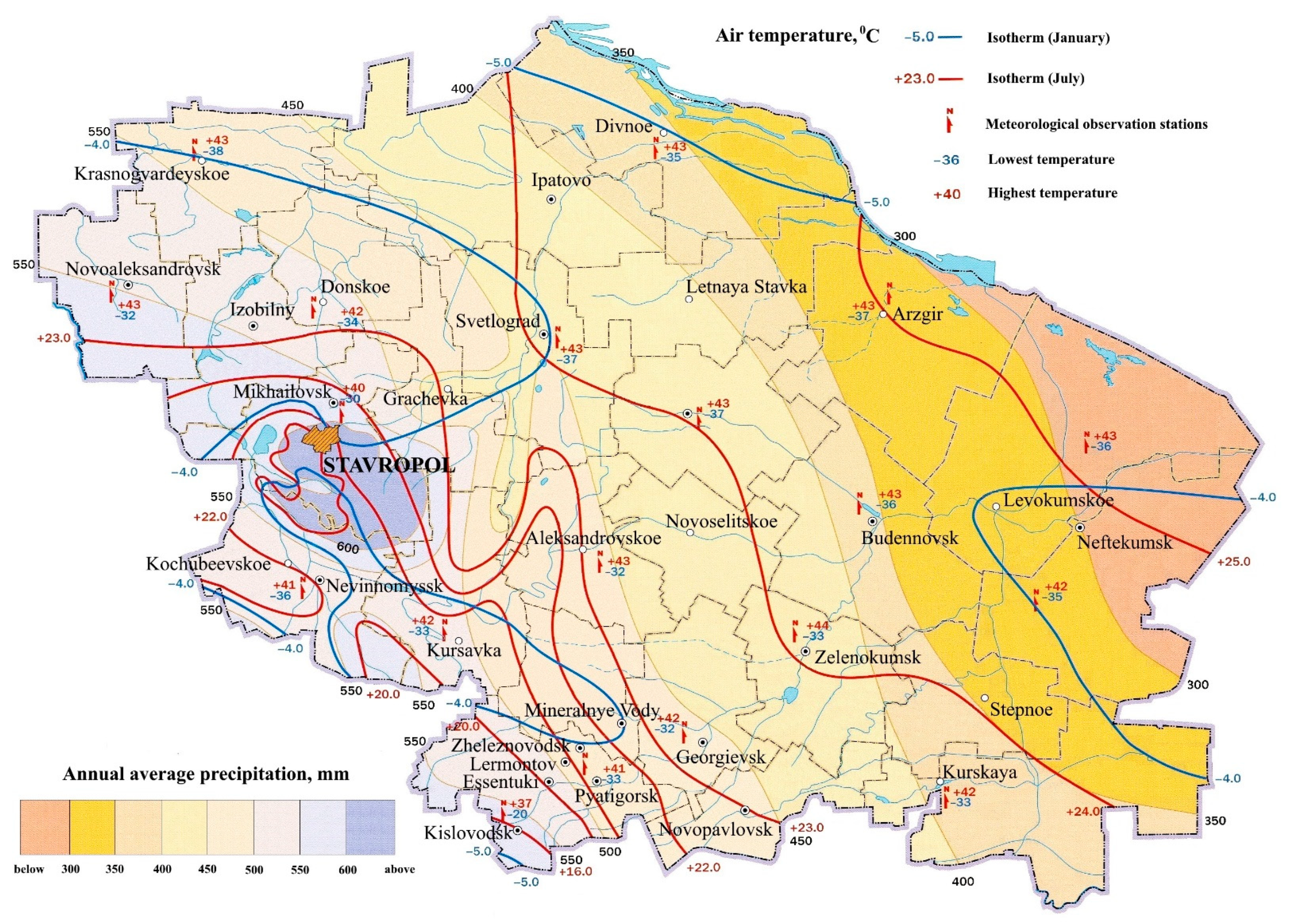
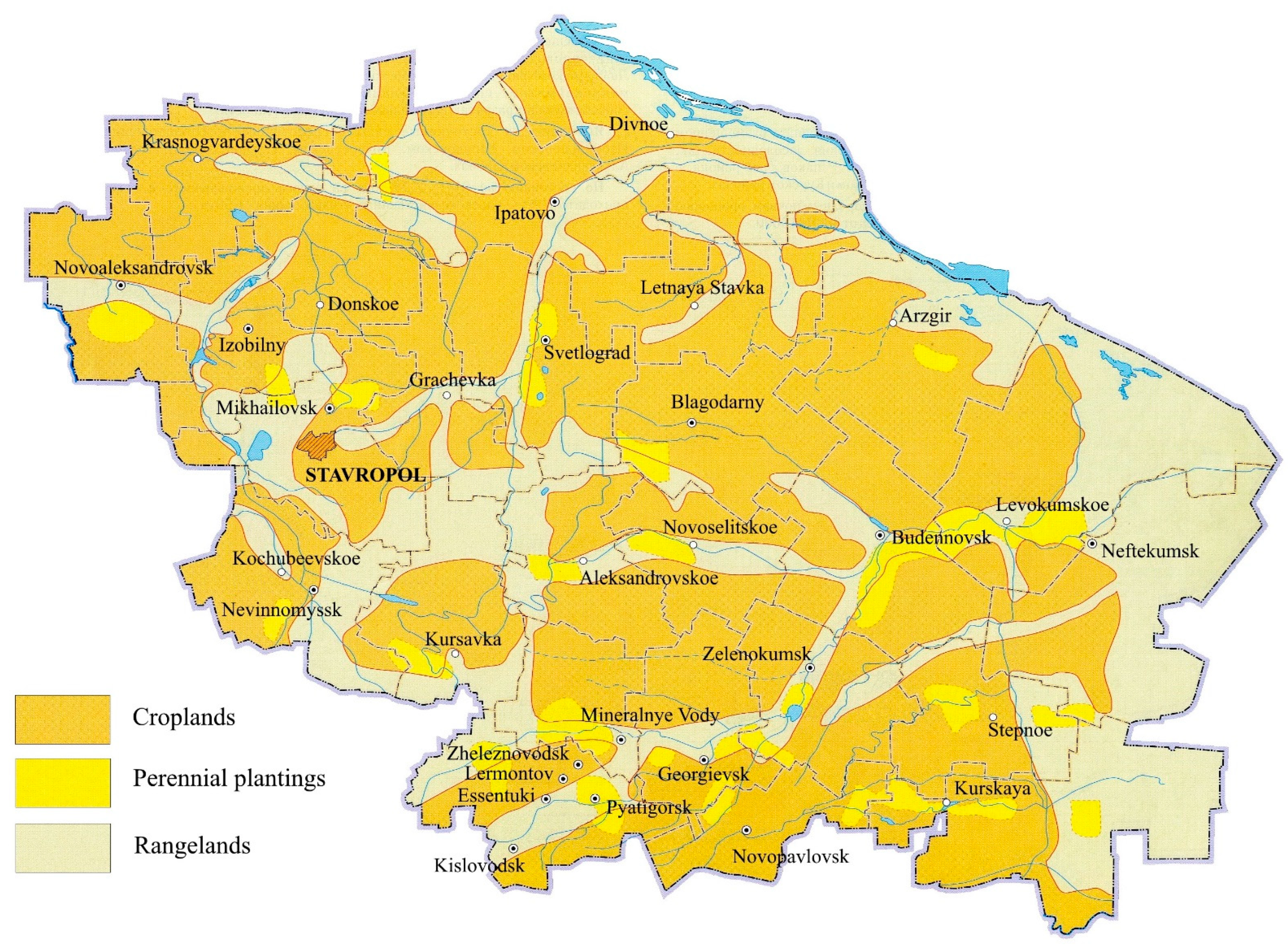
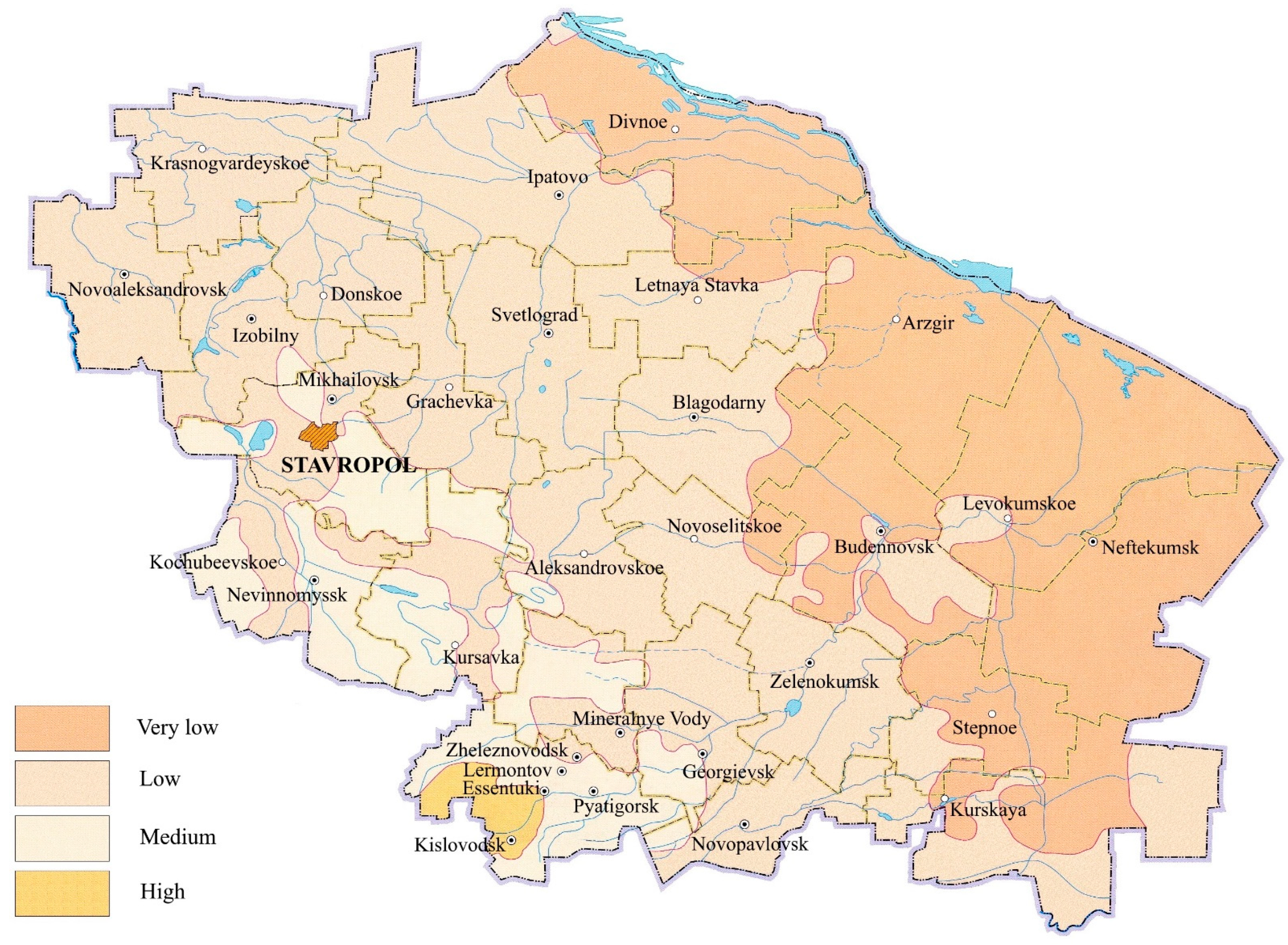
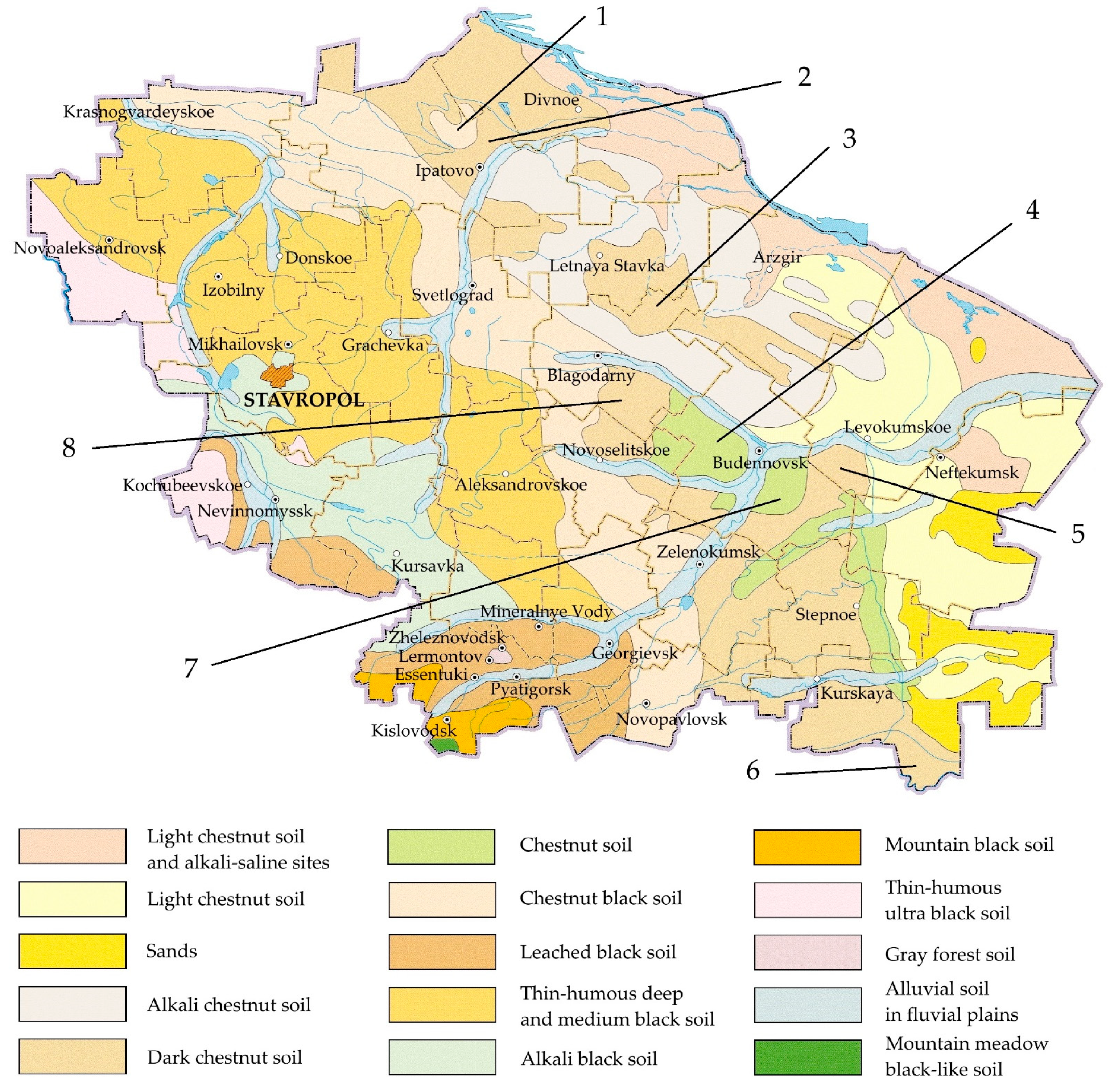
| Stage | Autocorrelation Parameter p | Standard Error | Multiple Correlation Coefficient R | R-Squared Coefficient | Adjusted R-Squared Coefficient | Root Mean Standard Error | Durbin– Watson Statistic |
|---|---|---|---|---|---|---|---|
| I | 0.271 | 0.185 | 0.239 | 0.057 | −0.051 | 2.113 | 1.582 |
| II | 0.352 | 0.163 | 0.046 | 0.002 | −0.091 | 3.209 | 1.973 |
| III | 0.276 | 0.160 | 0.255 | 0.065 | −0.015 | 5.508 | 1.791 |
| IV | 0.601 | 0.160 | 0.138 | 0.019 | −0.104 | 5.669 | 2.137 |
| Stage | Variable/ Parameter | Non-Standardized Coefficient | Standard Error | Standardized Coefficient | T | Value |
|---|---|---|---|---|---|---|
| I | XT | −0.368 | 0.431 | −0.553 | −0.854 | 0.401 |
| XR | 0.013 | 0.012 | 0.704 | 1.087 | 0.287 | |
| Constant | 6.449 | 0.535 | 12.045 | 0.000 | ||
| II | XT | −0.003 | 0.138 | −0.005 | −0.020 | 0.984 |
| XR | −0.001 | 0.005 | −0.043 | −0.184 | 0.855 | |
| Constant | 7.698 | 0.890 | 8.645 | 0.000 | ||
| III | XT | 0.307 | 0.299 | 0.192 | 1.026 | 0.312 |
| XR | −0.010 | 0.006 | −0.285 | −1.524 | 0.136 | |
| Constant | 17.197 | 1.420 | 12.110 | 0.000 | ||
| IV | XT | −1.356 | 2.284 | −0.121 | −0.593 | 0.558 |
| XR | 0.034 | 0.139 | 0.050 | 0.244 | 0.809 | |
| Constant | 28.442 | 80.105 | 0.355 | 0.726 |
References
- Katsov, V.M.; Kobysheva, N.V.; Meleshko, V.P.; Porfiriev, B.N.; Revich, B.A.; Sirotenko, O.D.; Stadnik, V.V.; Khlebnikova, E.I.; Chicherin, S.S.; Shalygin, A.L. Assessment of Macroeconomic Consequences of Climate Change in the Russian Federation until 2030 and Further Perspective; D’ART: Moscow, Russia, 2011. [Google Scholar]
- Porfiriev, B. Nature and Economics: Risks of Interaction; Ankil: Moscow, Russia, 2011. [Google Scholar]
- Food and Agriculture Organization of the United Nations; International Fund for Agricultural Development; United Nations Children’s Fund; World Food Programme; World Health Organization. The State of Food Security and Nutrition in the World 2020. Transforming Food Systems for Affordable Healthy Diets; FAO: Rome, Italy, 2020. [Google Scholar] [CrossRef]
- Burnett, B. Climate Change Impacts on Crop Selection and Rotation in 2050. Available online: https://umanitoba.ca/faculties/afs/ncle/pdf/Ag2050_Essay_Burnett.pdf (accessed on 27 September 2021).
- International Food Policy Research Institute. 2019 Global Food Policy Report; International Food Policy Research Institute: Washington, DC, USA, 2019. [Google Scholar] [CrossRef]
- Lobell, D.; Field, C. Global scale climate-crop yield relationships and the impacts of recent warming. Environ. Res. Lett. 2007, 2, 014002. [Google Scholar] [CrossRef]
- Schellnhuber, H.J.; Rahmstorf, S.; Winkelmann, R. Why the right climate target was agreed in Paris. Nat. Clim. Chang. 2016, 6, 649–653. [Google Scholar] [CrossRef]
- Glantz, M.; Gommes, R.; Ramasamy, S. Coping with a Changing Climate: Considerations for Adaptation and Mitigation in Agriculture; FAO: Rome, Italy, 2009. [Google Scholar]
- Edenhofer, O.; Pichs-Madruga, R.; Sokona, Y.; Farahani, E.; Kadner, S.; Seyboth, K.; Adler, A.; Baum, I.; Brunner, S.; Eickemeier, P.; et al. Climate Change 2014: Mitigation of Climate Change: Working Group III Contribution to the IPCC Fifth Assessment Report; Cambridge University Press: Cambridge, UK, 2014. [Google Scholar]
- Rosengrant, M.; Wiebe, K.; Sulser, T.; Mason-D’Croz, D.; Willenbockel, D. Climate change and agricultural development. In Agricultural Development: New Perspectives in a Changing World; Otsuka, K., Fan, S., Eds.; International Food Policy Research Institute: Washington, DC, USA, 2021; pp. 629–660. [Google Scholar] [CrossRef]
- Jaeger, C.C.; Jaeger, J. Three views of two degrees. Reg. Environ. Chang. 2011, 11, 15–26. [Google Scholar] [CrossRef] [Green Version]
- Kimball, B. Carbon dioxide and agricultural yield: An assemblage and analysis of 430 prior observations. Agron. J. 1983, 75, 779–788. [Google Scholar] [CrossRef]
- Allen, L. Plant responses to rising carbon dioxide and potential interactions with air pollutants. J. Environ. Qual. 1990, 19, 15–34. [Google Scholar] [CrossRef]
- Keeling, C.D.; Whorf, T.P.; Wahlen, M.; van der Plichtt, J. Interannual extremes in the rate of rise of atmospheric carbon dioxide since 1980. Nature 1995, 375, 660–670. [Google Scholar] [CrossRef]
- Tubiello, F.; Ewert, F. Simulating the effects of elevated CO2 on crops: Approaches and applications for climate change. Eur. J. Agron. 2002, 18, 57–74. [Google Scholar] [CrossRef]
- Lal, R. Climate change and soil degradation mitigation by sustainable management of soils and other natural resources. Agric. Res. 2012, 1, 199–212. [Google Scholar] [CrossRef] [Green Version]
- Steffen, W.; Persson, Å.; Deutsch, L.; Zalasiewicz, J.; Williams, M.; Richardson, K.; Crumley, C.; Crutzen, P.; Folke, C.; Gordon, L.; et al. The anthropocene: From global change to planetary stewardship. AMBIO 2011, 40, 739. [Google Scholar] [CrossRef] [Green Version]
- Hamidov, A.; Helming, K.; Bellocchi, G.; Bojar, W.; Dalgaard, T.; Ghaley, B.B.; Hoffmann, C.; Holman, I.; Holzkämper, A.; Krzeminska, D.; et al. Impacts of climate change adaptation options on soil functions: A review of European case-studies. Land Degrad. Dev. 2018, 29, 2378–2389. [Google Scholar] [CrossRef]
- Lal, R.; Delgado, J.A.; Groffman, P.M.; Millar, N.; Dell, C.; Rotz, A. Management to mitigate and adapt to climate change. J. Soil Water Conserv. 2011, 66, 276–285. [Google Scholar] [CrossRef] [Green Version]
- Xiong, X.; Grunwald, S.; Myers, D.B.; Ross, C.W.; Harris, W.G.; Comerford, N.B. Interaction effects of climate and land use/land cover change on soil organic carbon sequestration. Sci. Total Environ. 2014, 493, 974–982. [Google Scholar] [CrossRef]
- Robinson, S.; Mason-D’Croz, D.; Islam, S.; Sulser, T.; Robertson, R.; Zhu, T.; Gueneau, A.; Pitois, G.; Rosengrant, M. The International Model for Policy Analysis of Agricultural Commodities and Trade (IMPACT); International Food Policy Research Institute: Washington, DC, USA, 2015. [Google Scholar]
- Robertson, R. Mink: Details of a Global Gridded Crop. Modeling System; International Food Policy Research Institute: Washington, DC, USA, 2017. [Google Scholar]
- Jones, J.W.; Hoogenboom, G.; Porter, C.H.; Boote, K.J.; Batchelor, W.D.; Hunt, L.A.; Wilkens, P.W.; Singh, U.; Gijsman, A.J.; Ritchie, J.T. DSSAT cropping system model. Eur. J. Agron. 2003, 18, 235–265. [Google Scholar] [CrossRef]
- Rosenzweig, C.; Jones, J.W.; Hatfield, J.L.; Ruane, A.C.; Boote, A.C.; Thorburn, P.; Antle, J.M.; Nelson, G.C.; Porter, C.; Janssen, S.; et al. The agricultural model intercomparison and improvement project (AgMIP): Protocols and pilot studies. Agric. For. Meteorol. 2013, 170, 166–182. [Google Scholar] [CrossRef] [Green Version]
- Rosenzweig, C.; Ruane, A.; Antle, J.; Elliott, J.; Ashfaq, M.; Chatta, A.A.; Ewert, F.; Folberth, C.; Hathie, I.; Havlik, P.; et al. Coordinating AgMIP data and models across global and regional scales for 1.5 °C and 2.0 °C assessments. Philos. Trans. R. Soc. A Math. Phys. Eng. Sci. 2018, 376, 20160455. [Google Scholar] [CrossRef]
- Moss, R.; Edmonds, J.; Hibbard, K.; Manning, M.; Rose, S.; van Vuuren, D.; Carter, T.; Emori, S.; Kainuma, M.; Kram, T.; et al. The next generation of scenarios for climate change research and assessment. Nature 2010, 463, 747–756. [Google Scholar] [CrossRef]
- Slingo, J.M.; Challinor, A.J.; Hoskins, B.J.; Wheeler, T.R. Introduction: Food crops in a changing climate. Philos. Trans. R. Soc. B Biol. Sci. 2005, 360, 1983–1989. [Google Scholar] [CrossRef] [Green Version]
- Betts, R. Integrated approaches to climate-crop modelling: Needs and challenges. Philos. Trans. R. Soc. B Biol. Sci. 2005, 360, 2049–2065. [Google Scholar] [CrossRef] [Green Version]
- Challinor, A.; Wheeler, T.; Garforth, C.; Craufurd, P.; Kassam, A. Assessing the vulnerability of food crop systems in Africa to climate change. Clim. Chang. 2007, 83, 381–399. [Google Scholar] [CrossRef]
- Singh, A.; Church, S.; Dang, L.; Hennes, E.; Prokopy, L. Does climate change framing matter? Evidence from an experiment of crop advisors in the Midwestern United States. Clim. Chang. 2020, 162, 1031–1044. [Google Scholar] [CrossRef]
- Chadalavada, K.; Kumari, B.D.R.; Kumar, T.S. Sorghum mitigates climate variability and change on crop yield and quality. Planta 2021, 253, 113. [Google Scholar] [CrossRef]
- Richardson, K.; Steffen, W.; Liverman, D. Climate Change: Global Risks, Challenges and Decisions; Cambridge University Press: Cambridge, UK, 2011. [Google Scholar]
- Tchijevsky, A. Physical factors of the historical process. Cycles 1971, 22, 11–27. [Google Scholar]
- Chaplitskaya, A.; Heijman, W.; Ophem, J.v.; Kusakina, O. Innovation policy and sustainable regional development in agriculture: A case study of the Stavropol territory, Russia. Sustainability 2021, 13, 3509. [Google Scholar] [CrossRef]
- Islas-Vargas, M. Adaptation to climate change: Definition, subjects and disputes. Let. Verdes Rev. Latinoam. Estud. Socioambientales 2020, 28, 9–30. [Google Scholar] [CrossRef]
- Moriondo, M.; Bindi, M.; Brilli, L.; Costafreda-Aumedes, S.; Dibari, C.; Leolini, L.; Padovan, G.; Trombi, G.; Karali, A.; Varotsos, K.V.; et al. Assessing climate change impacts on crops by adopting a set of crop performance indicators. Euro Mediterr. J. Environ. Integr. 2021, 6, 1–18. [Google Scholar] [CrossRef]
- Sarfaraz, S.; Shoukat, S.S.; Khan, T.M.A. Investigating wheat yield and climate parameters regression model based on Akaike information criteria. Pak. J. Bot. 2021, 53, 1299–1306. [Google Scholar] [CrossRef]
- Plastina, A.; Lence, S.H.; Ortiz-Bobea, A. How weather affects the decomposition of total factor productivity in U.S. agriculture. Agric. Econ. 2021, 52, 215–234. [Google Scholar] [CrossRef]
- Black, J.R.; Thompson, S.R. Some evidence on weather-crop-yield interaction. Am. J. Agric. Econ. 1978, 60, 540–543. [Google Scholar] [CrossRef]
- Adams, R.M.; Flemming, R.A.; Chang, C.C.; McCarl, B.; Rosenzweig, C. A Reassessment of the economic effects of global climate change on U.S. agriculture. Clim. Chang. 1995, 30, 147–167. [Google Scholar] [CrossRef]
- Brown, R.A.; Rosenberg, N.J. Climate change impacts on the potential productivity of corn and winter wheat in their primary United States growing regions. Clim. Chang. 1999, 41, 73–107. [Google Scholar] [CrossRef]
- Mearns, L.O.; Easterling, W.; Hays, C.; Marx, D. Comparison of agricultural impacts of climate change calculated from high and low resolution climate change scenarios: Part I. The uncertainty due to spatial scale. Clim. Chang. 2001, 51, 131–172. [Google Scholar] [CrossRef]
- Stockle, C.O.; Donatelli, M.; Nelson, R. CropSyst, a cropping systems simulation model. Eur. J. Agron. 2003, 18, 289–307. [Google Scholar] [CrossRef]
- Brisson, N.; Gary, C.; Justes, E.; Roche, R.; Mary, B.; Ripoche, D.; Zimmer, D.; Sierra, J.; Bertuzzi, P.; Burger, P.; et al. An overview of the crop model STICS. Eur. J. Agron. 2003, 18, 309–332. [Google Scholar] [CrossRef]
- Keating, B.A.; Carberry, P.S.; Hammer, G.L.; Probet, M.E.; Robertson, M.J.; Holzworth, D.; Huth, N.I.; Hargreaves, J.N.G.; Meinke, H.; Hochman, Z.; et al. An overview of APSIM, a model designed for farming systems simulation. Eur. J. Agron. 2003, 18, 267–288. [Google Scholar] [CrossRef] [Green Version]
- Challinor, A.J.; Wheeler, T.R.; Craufurd, P.Q.; Slingo, J.M.; Grimes, D.I.F. Design and optimization of a large-area process-based model for annual crops. Agric. For. Meteorol. 2004, 124, 99–120. [Google Scholar] [CrossRef]
- Rosenzweig, C.; Elliott, J.; Deryng, D.; Ruane, A.C.; Müller, C.; Arneth, A.; Boote, K.J.; Folberth, C.; Glotter, M.; Khabarov, N. Assessing agricultural risks of climate change in the 21st century in a global gridded crop model intercomparison. Pro. Natl. Acad. Sci. USA 2014, 111, 3268–3273. [Google Scholar] [CrossRef] [Green Version]
- Schlenker, W.; Hanemann, W.M.; Fisher, A.C. The impact of global warming on U.S. agriculture: An econometric analysis of optimal growing conditions. Rev. Econ. Stat. 2006, 88, 113–125. [Google Scholar] [CrossRef]
- Lobell, D.B.; Burke, M.B. On the use of statistical models to predict crop yield responses to climate change. Agric. For. Meteorol. 2010, 150, 1443–1452. [Google Scholar] [CrossRef]
- Lenton, T.; Held, H.; Kriegler, E.; Hall, J.; Lucht, W.; Rahmstorf, S.; Schellnhuber, H.J. Tipping elements in the Earth’s climate system. Pro. Natl. Acad. Sci. USA 2008, 105, 1786–1793. [Google Scholar] [CrossRef] [Green Version]
- Lockwood, J.G. Abrupt and sudden climatic transitions and fluctuations: A review. Int. J. Climatol. 2001, 21, 1153–1179. [Google Scholar] [CrossRef]
- Rial, J.A.; Pielke, R.A.; Beniston, M.; Claussen, M.; Canadell, J.; Cox, P.; Held, H.; de Noblet-Ducoudre, N.; Prinn, R.; Reynolds, J.; et al. Nonlinearities, feedbacks and critical thresholds within the Earth’s climate system. Clim. Chang. 2004, 65, 11–38. [Google Scholar] [CrossRef] [Green Version]
- Tao, F.; Yokozawa, M.; Zhang, Z.; Hayashi, Y.; Grassl, H.; Fu, C. Climatological and agricultural production variability in China in association with East Asia Monsoon and El Niño Southern Oscillation. Clim. Res. 2004, 28, 23–30. [Google Scholar] [CrossRef] [Green Version]
- Easterling, W.E.; Chen, X.; Hays, C.; Brandle, J.R.; Zhang, H. Improving the validation of model-simulated crop yield response to climate change: An application to the EPIC model. Clim. Res. 1996, 6, 263–273. [Google Scholar] [CrossRef]
- Ju, H.; Lin, E.; Wheeler, T.; Challinor, A.; Jiang, S. Climate change modelling and its roles to Chinese crops yield. J. Integr. Agric. 2013, 12, 892–902. [Google Scholar] [CrossRef]
- Tao, F.; Yokozawa, M.; Xu, Y.; Hayashi, Y.; Zhang, Z. Climate changes and trends in phenology and yields of field crops in China, 1981–2000. Agric. For. Meteorol. 2006, 138, 82–92. [Google Scholar] [CrossRef]
- Cui, X. Climate change and adaptation in agriculture: Evidence from US cropping patterns. J. Environ. Econ. Manag. 2020, 101, 102306. [Google Scholar] [CrossRef]
- Qiao, J.; Yu, D.; Wang, Q.; Liu, Y. Diverse effects of crop distribution and climate change on crop production in the agro-pastoral transitional zone of China. Front. Earth Sci. 2018, 12, 408–419. [Google Scholar] [CrossRef]
- Skrypnyk, A.; Zhemoyda, O.; Klymenko, N.; Galaieva, L.; Koval, T. Econometric analysis of the impact of climate change on the sustainability of agricultural production in Ukraine. J. Ecol. Eng. 2021, 22, 275–288. [Google Scholar] [CrossRef]
- Zougmoré, R.B.; Läderach, P.; Campbell, B.M. Transforming food systems in Africa under climate change pressure: Role of climate-smart agriculture. Sustainability 2021, 13, 4305. [Google Scholar] [CrossRef]
- Zhang, J.; Mishra, A.K.; Hirsch, S. Market-oriented agriculture and farm performance: Evidence from rural China. Food Policy 2021, 100, 102023. [Google Scholar] [CrossRef]
- Mitroshkin, K.; Pavlovsky, S. Forest and Field; Kolos: Moscow, Russia, 1979. [Google Scholar]
- Reidsma, P.; Wolf, J.; Kanellopoulos, A.; Schaap, B.; Mandryk, M.; Verhagen, J.; van Ittersum, M. Climate change impact and adaptation research requires integrated assessment and farming systems analysis: A case study in the Netherlands. Environ. Res. Lett. 2015, 10, 045004. [Google Scholar] [CrossRef]
- Dronin, N.; Kirilenko, A. Climate change, food stress, and security in Russia. Reg. Environ. Chang. 2011, 11, 167–178. [Google Scholar] [CrossRef]
- Olesen, J.E.; Trnka, M.; Kersebaum, C.-K.; Skjelvag, A.O.; Seguin, B.; Peltonen-Sainio, P.; Rossi, F.; Kozyra, J.; Micale, F. Impacts and adaptation of European crop production systems to climate change. Eur. J. Agron. 2011, 34, 96–112. [Google Scholar] [CrossRef]
- Gornall, J.; Betts, R.; Burke, E.; Clark, R.; Camp, J.; Willett, K.; Wiltshire, A. Implications of climate change for agricultural productivity in the early twenty-first century. Philos. Trans. R. Soc. B Biol. Sci. 2010, 365, 2973–2989. [Google Scholar] [CrossRef] [PubMed]
- Rötter, R.; Höhn, J.; Fronzek, S. Projections of climate change impacts on crop production: A global and a Nordic perspective. Acta Agric. Scand. Sect. A Anim. Sci. 2012, 62, 166–180. [Google Scholar] [CrossRef]
- Alcamo, J.; Dronin, N.; Endejan, M.; Golubev, G.; Kirilenko, A. A new assessment of climate change impacts on food production shortfalls and water availability in Russia. Glob. Environ. Chang. 2007, 17, 429–444. [Google Scholar] [CrossRef]
- Smith, P.; Smith, J.; Franko, U.; Kuka, K.; Romanenkov, V.; Shevtsova, L.; Wattenbach, M.; Gottschalk, P.; Sirotenko, O.; Rukhovich, D.; et al. Changes in mineral soil organic carbon stocks in the croplands of European Russia and the Ukraine, 1990–2070; comparison of three models and implications for climate mitigation. Reg. Environ. Chang. 2007, 7, 105–119. [Google Scholar] [CrossRef]
- Korsak, V.; Kravchuk, A.; Prokopets, R.; Nikishanov, A.; Arjanuhina, E. Scenarios of global warming and forecasting changes of agroclimatic resources of the Volga region. Agrar. Nauchnyy Zhurnal 2018, 1, 51–55. [Google Scholar] [CrossRef] [Green Version]
- Lobell, D.; Asner, G. Climate and management contributions to recent trends in US Agricultural Yields. Science 2003, 299, 1032. [Google Scholar] [CrossRef] [PubMed]
- Challinor, A.; Parkes, B.; Ramirez-Villegas, J. Crop yield response to climate change varies with cropping intensity. Glob. Chang. Biol. 2015, 21, 1679–1688. [Google Scholar] [CrossRef] [Green Version]
- White, J.W.; Hoogenboom, G.; Kimball, B.A.; Wall, G.W. Methodologies for simulating impacts of climate change on crop production. Field Crop. Res. 2011, 124, 357–368. [Google Scholar] [CrossRef] [Green Version]
- Rötter, R.P.; Carter, T.R.; Olesen, J.E.; Porter, J.R. Crop-climate models need an overhaul. Nat. Clim. Chang. 2011, 1, 175–177. [Google Scholar] [CrossRef]
- Claussen, M.; Brovkin, V.; Ganopolski, A.; Kubatzki, C.; Petoukhov, V. Climate change in Northern Africa: The past is not the future. Clim. Chang. 2003, 57, 99–118. [Google Scholar] [CrossRef] [Green Version]
- Berhane, A. Climate change and variability impacts on agricultural productivity and food security. J. Climatol. Weather Forecast. 2018, 6, 240. [Google Scholar] [CrossRef]
- Stanhill, G.; Cohen, S. Global dimming: A review of the evidence for a widespread and significant reduction in global radiation with discussion of its probable causes and possible agricultural consequences. Agric. For. Meteorol. 2001, 107, 255–278. [Google Scholar] [CrossRef]
- Dentener, F.; Stevenson, D.; Cofala, J.; Mechler, R.; Amann, M.; Bergamaschi, P.; Raes, F.; Derwent, R. The impact of air pollutant and methane emission controls on tropospheric ozone and radiative forcing: CTM calculations for the period 1990–2030. Atmos. Chem. Phys. 2005, 5, 1731–1755. [Google Scholar] [CrossRef] [Green Version]
- Vaughan, M.M.; Block, A.; Christensen, S.A.; Allen, L.H.; Schmelz, E.A. The effects of climate change associated abiotic stresses on maize phytochemical defenses. Phytochem. Rev. 2018, 17, 37–49. [Google Scholar] [CrossRef]
- Lesk, C.; Rowhani, P.; Ramankutty, N. Influence of extreme weather disasters on global crop production. Nature 2016, 529, 84–87. [Google Scholar] [CrossRef]
- Pachauri, R.K.; Allen, M.R.; Barros, V.R.; Broome, J.; Cramer, W.; Christ, R.; Church, J.A.; Clarke, L.; Dahe, Q.; Dasgupta, P. Climate Change 2014: Synthesis Report; IPCC: Geneva, Switzerland, 2014. [Google Scholar]
- Rogelj, J.; den Elzen, M.; Höhne, N.; Fransen, T.; Fekete, H.; Winkler, H.; Schaeffer, R.; Fu, S.; Riahi, K.; Meinshausen, M. Paris Agreement climate proposals need a boost to keep warming well below 2 °C. Nature 2016, 534, 631–639. [Google Scholar] [CrossRef] [PubMed] [Green Version]
- Raza, A.; Razzaq, A.; Mehmood, S.S.; Zou, X.; Zhang, X.; Lv, Y.; Xu, J. Impact of climate change on crops adaptation and strategies to tackle its outcome: A review. Plants 2019, 8, 34. [Google Scholar] [CrossRef] [PubMed] [Green Version]
- Altieri, M.A.; Nicholls, C.I. The adaptation and mitigation potential of traditional agriculture in a changing climate. Clim. Chang. 2017, 140, 33–45. [Google Scholar] [CrossRef]
- Lin, B.B.; Perfecto, I.; Vandermeer, J. Synergies between agricultural intensification and climate change could create surprising vulnerabilities for crops. BioScience 2008, 58, 847–854. [Google Scholar] [CrossRef] [Green Version]
- Eakin, H. Smallholder maize production and climatic risk: A case study from Mexico. Clim. Chang. 2000, 45, 19–36. [Google Scholar] [CrossRef]
- Challinor, A.J.; Watson, J.; Lobell, D.B.; Howden, S.M.; Smith, D.R.; Chhetri, N. A meta-analysis of crop yield under climate change and adaptation. Nat. Clim. Chang. 2014, 4, 287–291. [Google Scholar] [CrossRef]
- Wheeler, T.; von Braun, J. Climate change impacts on global food security. Science 2013, 341, 55–60. [Google Scholar] [CrossRef] [PubMed]
- Ramirez-Villegas, J.; Lau, C.; Hooker, J.; Jarvis, A.; Ann-Kristin, K.; Arnell, N.; Tom, O. Climate Analogues: Finding Tomorrow’s Agriculture Today CGIAR Research Program. on Climate Change; Agriculture and Food Security (CCAFS): Copenhagen, Denmark, 2011. [Google Scholar]
- Egbebiyi, T.S.; Crespo, O.; Lennard, C. Defining crop-climate departure in West Africa: Improved understanding of the timing of future changes in crop suitability. Climate 2019, 7, 101. [Google Scholar] [CrossRef] [Green Version]
- Porter, J.R.; Semenov, M.A. Crop responses to climatic variation. Philos. Trans. R. Soc. B Biol. Sci. 2005, 360, 2021–2035. [Google Scholar] [CrossRef]
- Gibbs, H.K.; Ruesch, A.S.; Achard, F.; Clayton, M.K.; Holmgren, P.; Ramankutty, N.; Foley, J.A. Tropical forests were the primary sources of new agricultural land in the 1980s and 1990s. Proc. Natl. Acad. Sci. USA 2010, 107, 16732–16737. [Google Scholar] [CrossRef] [Green Version]
- Smith, P. Delivering food security without increasing pressure on land. Glob. Food Secur. 2013, 2, 18–23. [Google Scholar] [CrossRef]
- Erokhin, V.; Gao, T. Handbook of Research on Globalized Agricultural Trade and New Challenges for Food Security; IGI Global: Hershey, PA, USA, 2020. [Google Scholar] [CrossRef]
- Rippke, U.; Ramirez-Villegas, J.; Jarvis, A.; Vermeulen, S.J.; Parker, L.; Mer, F.; Diekkrüger, B.; Challinor, A.J.; Howden, M. Timescales of transformational climate change adaptation in Sub-Saharan African agriculture. Nat. Clim. Chang. 2016, 6, 605–609. [Google Scholar] [CrossRef]
- Erokhin, V.; Gao, T.; Ivolga, A. Structural variations in the composition of land funds at regional scales across Russia. Land 2020, 9, 201. [Google Scholar] [CrossRef]
- Mather, A.S.; Needle, C.L. The forest transition: A theoretical basis. Area 1998, 30, 117–124. [Google Scholar] [CrossRef]
- dos Santos, J.; Fushita, A.; de Souza, I.; Amorim, L.; Andrade, V. Agriculture and forest transition: Understanding of land use change in a cultural landscape. Open J. Appl. Sci. 2015, 5, 797–807. [Google Scholar] [CrossRef] [Green Version]
- Zhang, H.; Xu, E.; Zhu, H. Ecological-living-productive land classification system in China. J. Resour. Ecol. 2017, 8, 121–128. [Google Scholar] [CrossRef]
- Trukhachev, V.; Ivolga, A.; Lescheva, M. Enhancement of land tenure relations as a factor of sustainable agricultural development: Case of Stavropol Krai, Russia. Sustainability 2015, 7, 164–179. [Google Scholar] [CrossRef] [Green Version]
- Smirnov, V.; Mulendeeva, A. A structural analysis of land use in Russia. Natl. Interests Priorities Secur. 2019, 15, 1057–1074. [Google Scholar] [CrossRef]
- Giorgi, F.; Mearns, L.O. Approaches to the simulation of regional climate change: A review. Rev. Geophys. 1991, 29, 191–216. [Google Scholar] [CrossRef]
- Risbey, J.S.; Stone, P.H. A Case study of the adequacy of GCM simulations for input to regional climate change assessments. J. Clim. 1996, 9, 1441–1467. [Google Scholar] [CrossRef]
- Villoria, N.; Byerlee, D.; Stevenson, J. The effects of agricultural technological progress on deforestation: What do we really know? Appl. Econ. Perspect. Policy 2014, 36, 211–237. [Google Scholar] [CrossRef]
- Wang, W.; Guo, L. Sources of production growth in Chinese agriculture: Empirical evidence from panel data results 2001–2018. Appl. Econ. 2021, 53, 5135–5157. [Google Scholar] [CrossRef]
- Hertel, T. Implications of Agricultural Productivity for Global Cropland Use and GHG Emissions: Borlaug vs. Jevons; Purdue University: West Lafayette, IN, USA, 2012. [Google Scholar]
- Loshakov, A. Condition and use of the land fund of Stavropol region. Econ. Ecol. Territ. Form. 2018, 2, 114–123. [Google Scholar] [CrossRef]
- Petrova, L.; Eroshenko, F.; Eroshenko, A. Productivity of winter wheat in different soil and climatic zones of the North Caucasus. Achiev. Sci. Technol. Agric. Ind. Complex. 2015, 29, 80–84. [Google Scholar]
- Center for Hydrometeorology and Environmental Monitoring of Stavropol Krai. Hydrometeorological Information. Available online: http://stavpogoda.ru/u_monit.shtml (accessed on 25 November 2021).
- Weather and Climate. Stavropol Climate Chronicle. Available online: http://www.pogodaiklimat.ru/history/34949.htm (accessed on 25 November 2021).
- Kulinstev, V.; Godunova, E.; Zhelnakova, L.; Udovydchenko, V.; Petrova, L.; Dridiger, V.; Antonov, S.; Andrianov, D.; Dzybov, D.; Kravtsov, V.; et al. The System of Agriculture of the New Generation of the Stavropol Territory; AGRUS: Stavropol, Russia, 2013. [Google Scholar]
- Bondar, I. Socio-Economic Support for the Integration of the Ciscaucasia into the System of Agrarian Capitalism in Russia: The Second Half of the XIX Century – Beginning of the XX Century (On the Case of Stavropol and Kuban); North Osetia State University: Vladikavkaz, Russia, 2012. [Google Scholar]
- Korobeynikov, A. Essays on the Development of the Stavropol Territory; Stavropol Publishing House: Stavropol, Russia, 1986. [Google Scholar]
- Stavropol Provincial Statistics Committee. Review of the Stavropol Province in 1890; Publishing House of the Provincial Government: Stavropol, Russia, 1891.
- Ryabov, E. Wind Erosion (Deflation) and Measures to Prevent It; Stavropol Publishing House: Stavropol, Russia, 1996. [Google Scholar]
- Shatsky, P. Agriculture of the Ciscaucasia in 1861–1905; USSR Academy of Sciences: Leningrad, Russia, 1970. [Google Scholar]
- Kochura, D.; Nevskaya, V. Our Region. Stavropol: Essays of History; Shat-gora: Stavropol, Russia, 1999. [Google Scholar]
- Krasnov, G. Struggle for the Alteration of the Nature of Stavropol; Stavropol Publishing House: Stavropol, Russia, 1952. [Google Scholar]
- Ryabov, E. Erosion and Deflation as the Main Factors of Desertification of the Territory and Measures to Overcome Them; Stavropol Publishing House: Stavropol, Russia, 2001. [Google Scholar]
- Samofalova, M.; Khachaturova, L. Experience of Hydrometeorological Support of the National Economy of the Stavropol Territory; Gidrometeoizdat: Stavropol, Russia, 1983. [Google Scholar]
- Ryabov, E. Influence of Unfavorable Weather Conditions on the Crop and Land Resources of the Stavropol Territory; Stavropol Publishing House: Stavropol, Russia, 2001. [Google Scholar]
- Nikolsky, S. Agrarian Course of Russia (The Worldview of Reformers and the Practice of Agrarian Reforms in Socio-Historical, Economic and Philosophical Aspects); Kolos: Moscow, Russia, 2003. [Google Scholar]
- Directorate of the Federal State Statistics Service of the Russian Federation for North Caucasian Federal District. Official Statistics. Available online: https://stavstat.gks.ru/ofstatistics (accessed on 25 November 2021).
- Skorkina, N. Stavropol Krai in Figures. Statistical Yearbook; Directorate of the Federal State Statistics Service of the Russian Federation for North Caucasian Federal District: Stavropol, Russia, 2020.
- Zhernovoy, V. The general rise is planned. Agriculture 1999, 4, 14–15. [Google Scholar]
- Wiebe, K.; Lotze-Campen, H.; Sands, R.; Tabeau, A.; van der Mensbrugghe, D.; Biewald, A.; Bodirsky, B.; Islam, S.; Kavallari, A.; Mason-D’Croz, D.; et al. Climate change impacts on agriculture in 2050 under a range of plausible socioeconomic and emissions scenarios. Environ. Res. Lett. 2015, 10, 085010. [Google Scholar] [CrossRef]
- Chen, Q.; Liu, Y.; Ge, Q.; Pan, T. Impacts of historic climate variability and land use change on winter wheat climatic productivity in the North China Plain during 1980–2010. Land Use Policy 2018, 76, 1–9. [Google Scholar] [CrossRef]
- Kaya, Y. Winter wheat adaptation to climate change in Turkey. Agronomy 2021, 11, 689. [Google Scholar] [CrossRef]
- Rusakova, T.; Lebedeva, V.; Gringof, I. Studying climate-related yield fluctuations of basic grain crops and their qualitative assessment under new socioeconomic conditions of the Russian Federation. Russ. Meteorol. Hydrol. 2010, 35, 851–857. [Google Scholar] [CrossRef]
- Pismennaya, E.; Stukalo, V. Trends in use of the steppe land resources of Stavropol region in different periods of the agrarian economy. South. Russ. Ecol. Dev. 2017, 12, 79–89. [Google Scholar] [CrossRef] [Green Version]
- Sanin, S. Protection of wheat against diseases in modern intensive technologies of its cultivation in the Central Region of Russia. Legumes Groat Crop. 2013, 6, 34–40. [Google Scholar]
- Belyaev, N.; Dubinkina, E. Assessment of adaptation of winter wheat varieties in conditions of Central Chernozem. Legumes Groat Crop. 2018, 27, 91–95. [Google Scholar] [CrossRef]
- Goryanin, O.; Madyakin, E.; Dzhangabaev, B.; Yakovleva, N. The improvement of the winter wheat cultivation technology in arid conditions of the Povolzhie. Grain Econ. Russ. 2021, 1, 52–56. [Google Scholar] [CrossRef]
- Shaykova, T.; Dyatlova, M.; Volkova, E.; Stepanova, I. Grain productivity of winter wheat as affected by complex fertilizers in the North-West of Russia. Fodd. Prod. 2020, 5, 30–34. [Google Scholar]
- Shpanev, A. Harmfulness of weed plants in winter wheat crops in the North-West of Russia. Plant. Prot. News 2018, 2, 42–46. [Google Scholar] [CrossRef] [Green Version]
- Toropova, E.; Stetsov, G.; Peshkov, S. Phytosanitary bases of winter wheat cultivation in Western Siberia. Prot. Quar. Plants 2021, 1, 28–37. [Google Scholar] [CrossRef]
- Sthapit, B.; Vasudeva, R.; Rajan, S.; Sripinta, P.; Reddy, B.M.C.; Arsanti, I.W.; Idris, S.; Lamers, H.; Ramanatha Rao, V. On-farm conservation of tropical fruit tree diversity: Roles and motivations of custodian farmers and emerging threats and challenges. Acta Hortic. 2015, 1101, 69–74. [Google Scholar] [CrossRef]
- Rosenzweig, C.; Parry, M. Potential impact of climate-change on world food-supply. Nature 1994, 367, 133–138. [Google Scholar] [CrossRef]
- Parry, M.; Rosenzweig, C.; Livermore, M. Climate change, global food supply and risk of hunger. Philos. Trans. R. Soc. B Biol. Sci. 2005, 360, 2125–2138. [Google Scholar] [CrossRef] [PubMed] [Green Version]
- Fischer, G.; Shah, M.; Tubiello, F.; van Velhuizen, H. Socio-economic and climate change impacts on agriculture: An integrated assessment, 1990–2080. Philos. Trans. R. Soc. B Biol. Sci. 2005, 360, 2067–2083. [Google Scholar] [CrossRef]
- Schlenker, W.; Roberts, M.J. Nonlinear temperature effects indicate severe damages to U.S. crop yields under climate change. Proc. Natl. Acad. Sci. USA 2009, 106, 15594–15598. [Google Scholar] [CrossRef] [PubMed] [Green Version]
- Greene, D.; Sutherland, S.; Kirkham, M. Influence of area on winter wheat climatic models. Clim. Chang. 1979, 2, 21–32. [Google Scholar] [CrossRef]
- Rudel, T.; Schneider, L.; Uriarte, M.; Turner, B.L.; DeFries, R.; Lawrence, D.; Geoghegan, J.; Hecht, S.; Ickowitz, A.; Lambin, E.; et al. Agricultural intensification and changes in cultivated areas, 1970–2005. Proc. Natl. Acad. Sci. USA 2009, 106, 20675–20680. [Google Scholar] [CrossRef] [Green Version]
- Neumann, K.; Verburg, P.; Stehfest, E.; Müller, C. The yield gap of global grain production: A spatial analysis. Agric. Syst. 2010, 103, 316–326. [Google Scholar] [CrossRef]
- Licker, R.; Kucharik, C.; Dore, T.; Lindeman, M.; Makowski, D. Climatic impacts on winter wheat yields in Picardy, France and Rostov, Russia: 1973–2010. Agric. For. Meteorol. 2013, 176, 25–37. [Google Scholar] [CrossRef]
- Savchenko, I.; Pryanishnikov, A.; Shabaev, A. Scientific coverage of stable agricultural production under conditions of growing climate iridizations. Russ. Agric. Sci. 2014, 6, 18–20. [Google Scholar]
- Pismennaya, E.; Loshakov, A.; Odinsov, S.; Stukalo, V. Improving model of territorial organization of agricultural land tenure. Res. J. Pharm. Biol. Chem. Sci. 2016, 7, 1783–1787. [Google Scholar]
- Savin, I.; Stolbovoy, V.; Savitskaya, N. Climatic potential for winter wheat yield in Russia. Russ. Agric. Sci. 2017, 43, 296–299. [Google Scholar] [CrossRef]
- Liu, J.; Dong, C.; Liu, S.; Rahman, S.; Sriboonchitta, S. Sources of total-factor productivity and efficiency changes in China’s agriculture. Agriculture 2020, 10, 279. [Google Scholar] [CrossRef]
- Loncaric, R.; Loncaric, Z.; Zmaic, K. Economic effects of winter wheat fertilization. Cereal Res. Commun. 2006, 34, 825–828. [Google Scholar] [CrossRef]
- Kulhánek, M.; Balík, J.; Černý, J.; Peklová, L.; Sedlář, O. Winter wheat fertilizing using nitrogen-sulphur fertilizer. Arch. Agron. Soil Sci. 2014, 60, 67–74. [Google Scholar] [CrossRef]
- Burykina, S.; Kryvenko, A.; Solomonov, R.; Kapustina, G.; Drobitko, A. Efficiency of winter wheat fertilization systems in the steppe zone of Southern Ukraine. Int. J. Ecosyst. Ecol. Sci. 2021, 11, 819–830. [Google Scholar] [CrossRef]
- Cronin, J.; Zabel, F.; Dessens, O.; Anandarajah, G. Land suitability for energy crops under scenarios of climate change and land-use. Glob. Chang. Biol. Bioenergy 2020, 12, 648–665. [Google Scholar] [CrossRef]
- Pavlova, V.; Shkolnik, I.; Pikaleva, A.; Efimov, S.; Karachenkova, A.; Kattsov, V. Future changes in spring wheat yield in the European Russia as inferred from a large ensemble of high-resolution climate projections. Environ. Res. Lett. 2019, 14, 034010. [Google Scholar] [CrossRef]
- Pavlova, V.; Calanca, P.; Karachenkova, A. Grain Crops Productivity in the European Part of Russia under Recent Climate Change. Russ. Meteorol. Hydrol. 2020, 45, 290–302. [Google Scholar] [CrossRef]
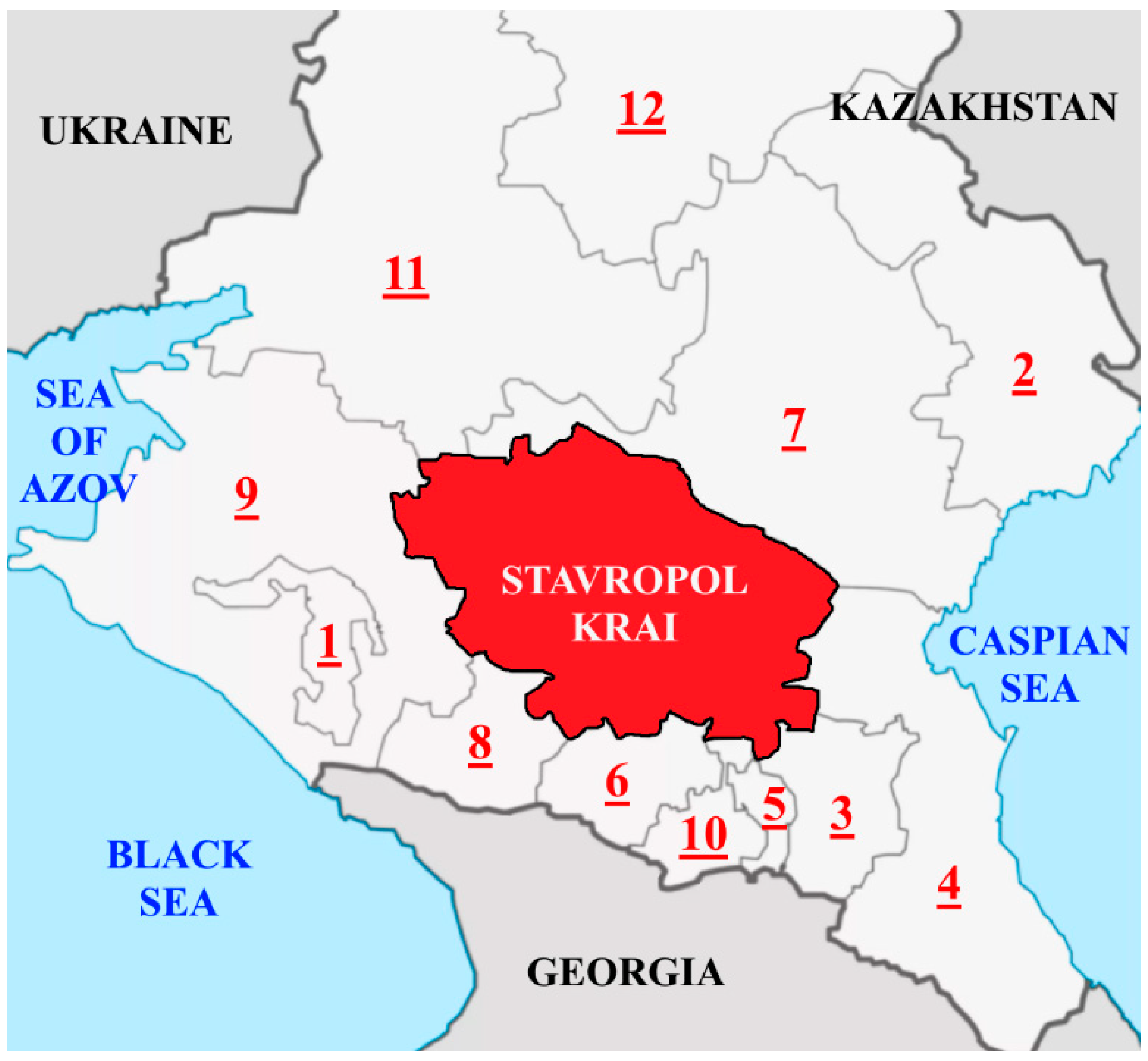

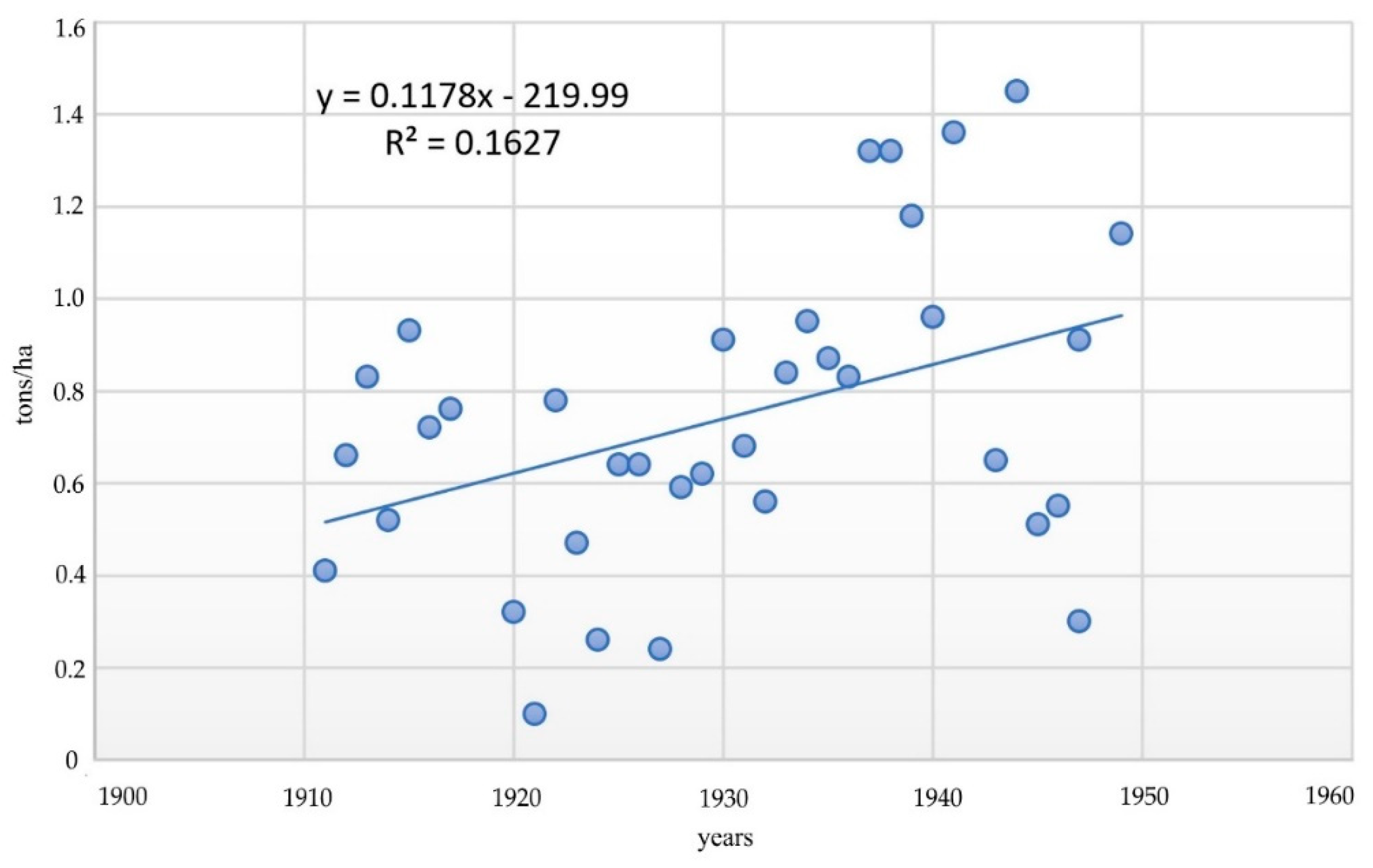
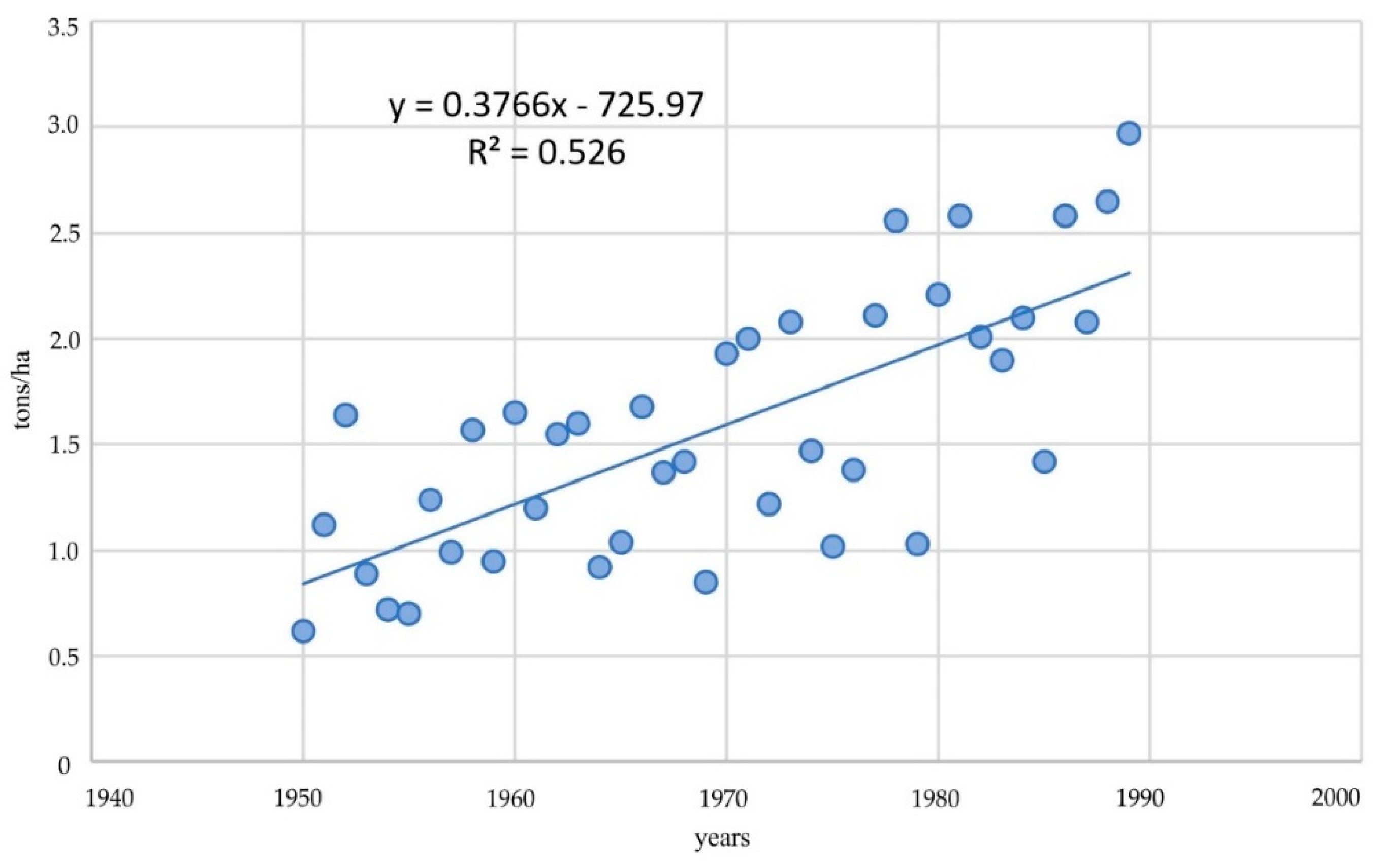
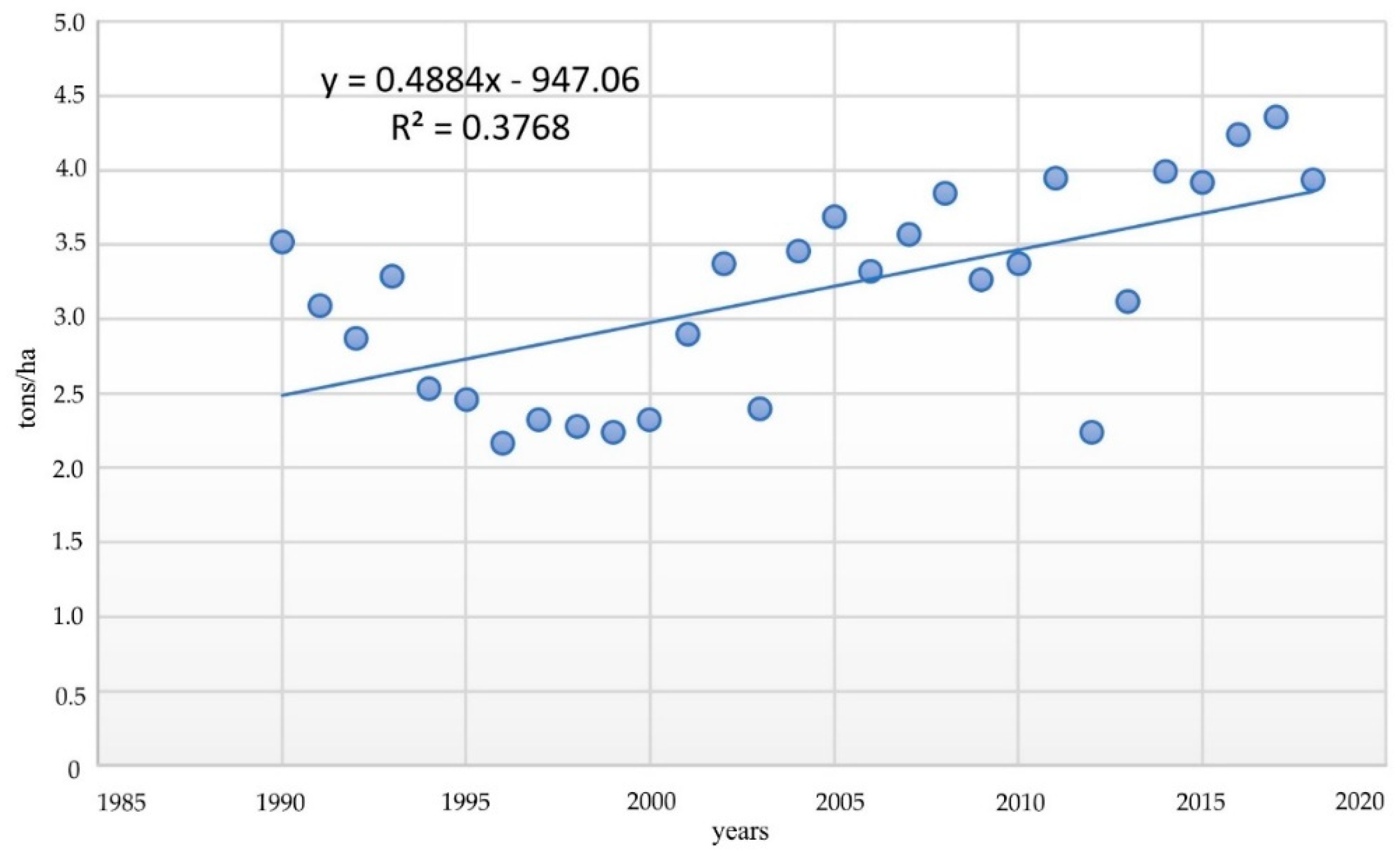
| Stage | Years | Agricultural Production | Land Use Patterns | Soil Quality | Winter Wheat Yields, tons/ha |
|---|---|---|---|---|---|
| I | 1850–1910 | Establishment of the grain production cluster in the south of Russia. | Misbalances in land use patterns. Countervailing of rangelands and lands under crops in the total land use. | Early manifestations of soil erosion and soil blowing. | 0.15–1.00 |
| II | 1910–1950 | Temporal drops in output (civil tensions and wars in 1917–1922 and 1941–1945). | Intensification of crop production. Development of irrigation and water distribution systems. | Adverse environmental impacts and deterioration in the quality of soils. | 1.00–1.50 |
| III | 1950–1990 | Switch to adaptive development of crop production. Enhancing the productivity of crop farming. | Widespread amelioration (chemical, water, forest, etc.). Technical and technological modernization of crop production. | Accelerated degradation of soils and loss of agricultural lands, adverse environmental impacts. | 1.50–3.00 |
| IV | 1990–2020 | Breaking of established value chains amid the dissolution of the Soviet Union. Deterioration of the basic infrastructure in the crop sector. | Market reforms in the agricultural sector. The market for agricultural land. Diverse organizational forms of land use. | Intense soil erosion and soil blowing, arable land loss, transfer of agricultural lands to non-agricultural uses. | 3.00–4.14 |
| Stage | Parameters | Climate Impact (V) | |||||
|---|---|---|---|---|---|---|---|
| Air temperature (T), °C | Precipitation (R), mm | ||||||
| Min * | Mean ** | Max *** | Min * | Mean ** | Max *** | ||
| I | 7.6 (1878) | 11.1 ± 0.4 | 11.4 (1890) | 240 (1900) | 415.0 ± 90.0 | 525 (1895) | 37.4 ± 45.2 |
| II | 7.7 (1929) | 11.3 ± 0.4 | 11.9 (1935) | 275 (1940) | 367.4 ± 71.0 | 529 (1945) | 32.5 ± 35.3 |
| III | 7.7 (1976) | 10.4 ± 1.1 | 11.5 (1966) | 286 (1954) | 399.2 ± 68.5 | 546 (1951) | 38.4 ± 33.7 |
| IV | 7.4 (1993) | 10.5 ± 0.6 | 11.7 (2010) | 255 (1995) | 525.0 ± 70.7 | 554 (2017) | 50.5 ± 34.7 |
| Farming System | Specialization | Stages | Composition of the Agricultural Land Fund, Share in Total, % | Land Use Equation (2) | ||||
|---|---|---|---|---|---|---|---|---|
| SC | SR + SH | SPP | SPPL | SOL | ||||
| Dryland farming | Developing crop production, advanced livestock production | I and II | 10.0 | 80.0 | 1.0 | 0.0 | 9.0 | |
| Irrigation farming | Advanced crop production, advanced livestock production | III | 60.0 | 30.0 | 0.7 | 1.0 | 8.3 | |
| Dryland farming | Advanced crop production, degrading livestock production | IV | 70.0 | 20.0 | 0.7 | 1.0 | 8.3 | |
| Stage | Parameters | Linear Regression Equation | Regression Coefficient R | ||||
|---|---|---|---|---|---|---|---|
| Y | G | C | O | M | |||
| I | 0.46 ± 0.20 | No data | No data | No data | No data | 0.11 | |
| II | 0.74 ± 0.26 | 0.655 ± 0.252 | No data | No data | No data | 0.12 | |
| III | 1.58 ± 0.50 | 2.657 ± 0.870 | 40.2 ± 27.9 | 9.0 ± 2.1 | 190.2 ± 90.7 | 0.40 | |
| IV | 3.17 ± 0.57 | 4.192 ± 1.185 | 10.8 ± 2.2 | 3.6 ± 1.8 | 88.8 ± 24.6 | 0.20 | |
| Stage | Model |
|---|---|
| I | |
| II | |
| III | |
| IV | |
| Average |
| Site * | Zone | Soil Type | C | Tw | Ts | R | Erodibility | |
|---|---|---|---|---|---|---|---|---|
| by Water | by Wind | |||||||
| 1 | 1 | Chestnut black soil | Low | −4.0 | +24.0 | 400–450 | Nonerodible | Strong |
| 2 | 1 | Dark chestnut soil | Low | −4.0 | +24.0 | 350–400 | Nonerodible | Medium |
| 3 | 1 | Dark chestnut soil | Low | −4.0 | +24.0 | 400–450 | Medium | Medium |
| 4 | 2 | Chestnut soil | Low | −4.0 | +24.0 | 350–400 | Nonerodible | Strong |
| 5 | 1 | Dark chestnut soil | Low | −4.0 | +24.0 | 300–350 | Nonerodible | Strong |
| 6 | 2 | Dark chestnut soil | Low | −4.0 | +23.0 | 350–400 | Nonerodible | Very strong |
| 7 | 2 | Chestnut soil | Low | −4.0 | +24.0 | 350–400 | Medium | Medium |
| 8 | 2 | Dark chestnut soil | Low | −4.0 | +23.0 | 400–450 | Nonerodible | Strong |
Publisher’s Note: MDPI stays neutral with regard to jurisdictional claims in published maps and institutional affiliations. |
© 2021 by the authors. Licensee MDPI, Basel, Switzerland. This article is an open access article distributed under the terms and conditions of the Creative Commons Attribution (CC BY) license (https://creativecommons.org/licenses/by/4.0/).
Share and Cite
Erokhin, V.; Esaulko, A.; Pismennaya, E.; Golosnoy, E.; Vlasova, O.; Ivolga, A. Combined Impact of Climate Change and Land Qualities on Winter Wheat Yield in Central Fore-Caucasus: The Long-Term Retrospective Study. Land 2021, 10, 1339. https://doi.org/10.3390/land10121339
Erokhin V, Esaulko A, Pismennaya E, Golosnoy E, Vlasova O, Ivolga A. Combined Impact of Climate Change and Land Qualities on Winter Wheat Yield in Central Fore-Caucasus: The Long-Term Retrospective Study. Land. 2021; 10(12):1339. https://doi.org/10.3390/land10121339
Chicago/Turabian StyleErokhin, Vasilii, Alexander Esaulko, Elena Pismennaya, Evgeny Golosnoy, Olga Vlasova, and Anna Ivolga. 2021. "Combined Impact of Climate Change and Land Qualities on Winter Wheat Yield in Central Fore-Caucasus: The Long-Term Retrospective Study" Land 10, no. 12: 1339. https://doi.org/10.3390/land10121339







